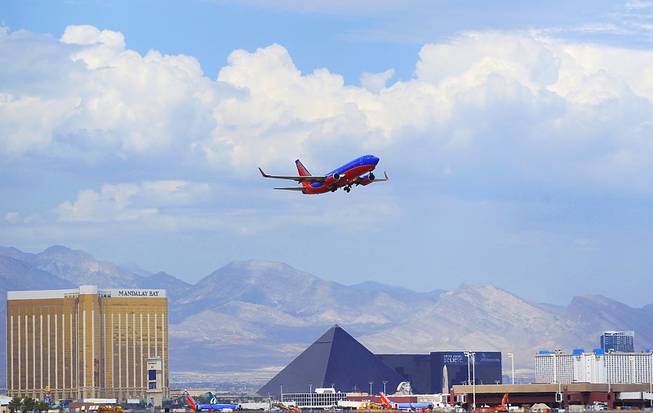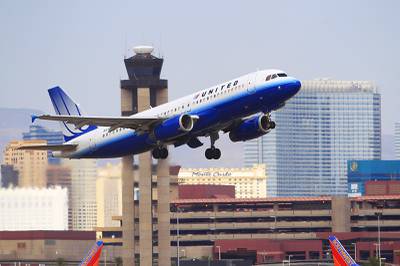
A Southwest Airlines jet takes off from McCarran International Airport on Friday, Aug. 26, 2011.
Wednesday, July 11, 2012 | 2 a.m.
Sun coverage
The soaring temperatures that Las Vegas is experiencing this week could cause grief for pilots at other airports, because heat thins the air and makes it more difficult for aircraft to lift at take-off. To deal with that, pilots need to gain more momentum as they roll down the runway before reaching liftoff speed.
But McCarran International Airport has two built-in advantages that help pilots deal with extreme heat: an exceptionally long runway and one that goes downhill just enough -- 1.1 degree over its 14,505-foot-length -- to help jets reach takeoff speed. The airport was designed that way because of our desert environment.
The alternative at airports that aren't built with extreme temperatures in mind: Aircraft might have to take off with fewer passengers to lessen their weight, or with less fuel, requiring a refueling stop along the way to its destination that normally wouldn't be necessary.
So far during the recent heat wave, when temperatures have climbed to near record-setting levels in the 115-degree range, Southwest Airlines, the busiest airline at McCarran, hasn’t had to disrupt any travel plans, though it could if some variables were to change.
“We’re always in communication with the pilot on every flight,” said Steve West, senior director of the operations coordination center for Southwest in Dallas, which operates a dispatch center monitoring every Southwest flight.
“They have onboard computers that monitor the plane’s weight, the temperature, the wind, the runway conditions and the weather along the route,” West said. “We have similar operational performance formulas in our computers for every plane here.”
As the temperature climbs, the so-called “density altitude” rises. That’s an important flight variable, said Jeff Jorgensen, director of academics for Embry-Riddle Aeronautical University’s worldwide campus in Las Vegas and a commercially rated pilot.
Density altitude is calculated with the level of atmospheric pressure and temperature. McCarran is at 2,181 feet in elevation, but on hot days, the density altitude is closer to 5,000 feet, affecting not only an aircraft’s lift capability but its engine performance.
McCarran has the 27th longest runway in the world and the third longest among commercial airports in the United States at 14,505 feet.
Runway 25 Right/7 Left runs east-west, parallel to a second runway that is 10,525 feet long. It slopes slightly downward from west to east -- an advantage that prompts pilots to take off to the east more often when it is extremely hot. The normal take-off pattern is east-to-west.
“It’s not much, but it’s just enough to improve that takeoff run,” Jorgensen said of the slight slope.
West said that when the long runway is available for use — especially with the downhill run — it’s plenty long for Southwest’s Boeing 737-700 and -800 series jets.
But if the long runway isn’t available, airlines have other options, West said.
“It happens from time to time,” West said. “We’d have to reduce weight. That means we’d either have to take on less fuel and make a stop along the way or not take all the passengers.”
But that’s something that is planned well in advance of the flight and isn’t a decision reached when passengers are boarding.
“The long runway really helps us with that,” he said. “But if it isn’t available to us, we have to make decisions on what to do. If we have a long flight to Baltimore, for example, we could possibly stop in St. Louis rather than leave passengers behind.”
The airport in Phoenix, Sky Harbor International Airport, faces similar concerns on extraordinarily hot days.
“I remember back in 1990, the temperature reached 123.6 degrees in Phoenix,” Jorgensen said. “That was back before we had a lot of computer programs, but there were (aircraft) performance tables to guide us. Unfortunately, the performance tables cut off at 120 degrees, so several flights were grounded as a precaution. Today, we have the ability to compute all that.”
In Flagstaff, Ariz., in the 1980s, a U.S. Forest Service crew landed a plane loaded with firefighters and equipment at Pulliam Airport to fight a forest fire. But when it was time to leave, the plane was too heavy to get off the ground because of soaring temperatures and a runway that, at the time, was only 7,000 feet long.
The Forest Service ended up busing firefighters and their gear 60 miles east to Winslow, which had a longer runway, and the empty plane took off at night when temperatures were lower, picking up the crew there.


Join the Discussion:
Check this out for a full explanation of our conversion to the LiveFyre commenting system and instructions on how to sign up for an account.
Full comments policy